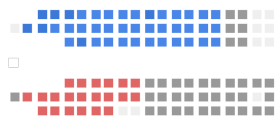Canadian Senate
|
Senate of Canada Sénat du Canada |
|
|---|---|
| 42nd Parliament | |
 |
|
| Type | |
| Type |
Upper House of the Parliament of Canada
|
| Leadership | |
|
Peter Harder, Non-affiliated
Since March 23, 2016 |
|
|
Leader of the Senate Liberal Caucus
|
|
| Structure | |
| Seats | 105 |
 |
|
|
Political groups
|
Non-affiliated (42)
Conservative Party (40)
Independent Liberals (20)
Vacant (3)
|
| Elections | |
| Appointment by the Governor-General on advice of the Prime Minister; non-binding elections are held in Alberta. | |
| Meeting place | |
 |
|
|
Centre Block - Parliament Hill Ottawa, Canada |
|
| Website | |
| www.parl.gc.ca | |
The Senate of Canada (French: Sénat du Canada) is a component of the Parliament of Canada, along with the House of Commons and the Monarch (represented by the Governor General). The Senate is modelled after the British House of Lords and consists of 105 members appointed by the Governor General on the advice of the Prime Minister. Seats are assigned on a regional basis: four regions—defined as Ontario, Quebec, the Maritime provinces, and the Western provinces—each receive 24 seats, with the remaining portions of the country—Newfoundland and Labrador and the three northern territories—assigned the remaining 9 seats apart from these regional divisions. Senators may serve until they reach the age of 75.
The Senate is the upper house of Parliament and the House of Commons is the lower house. This does not, however, imply that the Senate is more powerful than the House of Commons, merely that its members and officers outrank the members and officers of the Commons in the order of precedence for the purposes of protocol. As a matter of practice and custom, the Commons is the dominant chamber. The approval of both chambers is necessary for legislation and, thus, the Senate can reject bills passed by the Commons. Between 1867 and 1987, the Senate rejected fewer than two bills per year, but this has increased in more recent years. Moreover, members of the Cabinet are responsible solely to the House of Commons. While the prime minister and the rest of Cabinet remain in office only while they retain the confidence of the Commons, Senators are not beholden to such control. Although legislation can normally be introduced in either chamber, the majority of government bills originate in the House of Commons with the Senate acting as the chamber of "sober second thought" as it was called by Sir John A. Macdonald, Canada's first prime minister.
...
Wikipedia
